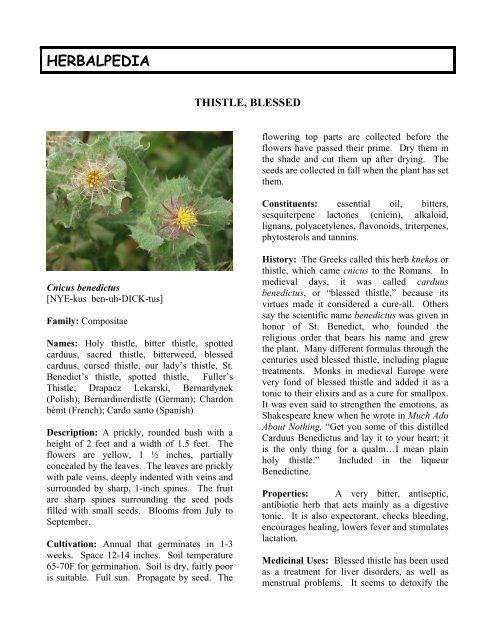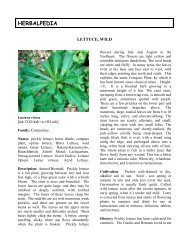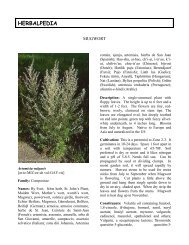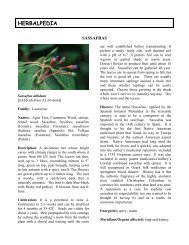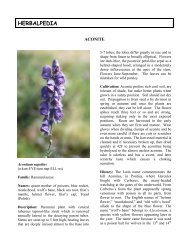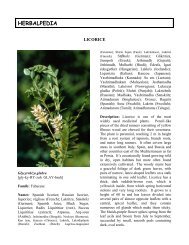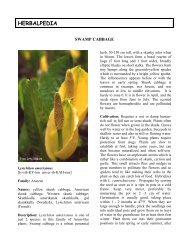Cnicus benedictus - HerbWorld
Cnicus benedictus - HerbWorld
Cnicus benedictus - HerbWorld
Create successful ePaper yourself
Turn your PDF publications into a flip-book with our unique Google optimized e-Paper software.
HERBALPEDIA<br />
<strong>Cnicus</strong> <strong>benedictus</strong><br />
[NYE-kus ben-uh-DICK-tus]<br />
Family: Compositae<br />
Names: Holy thistle, bitter thistle, spotted<br />
carduus, sacred thistle, bitterweed, blessed<br />
carduus, cursed thistle, our lady’s thistle, St.<br />
Benedict’s thistle, spotted thistle, Fuller’s<br />
Thistle; Drapacz Lekarski, Bernardynek<br />
(Polish); Bernardinerdistle (German); Chardon<br />
bénit (French); Cardo santo (Spanish)<br />
Description: A prickly, rounded bush with a<br />
height of 2 feet and a width of 1.5 feet. The<br />
flowers are yellow, 1 ½ inches, partially<br />
concealed by the leaves. The leaves are prickly<br />
with pale veins, deeply indented with veins and<br />
surrounded by sharp, 1-inch spines. The fruit<br />
are sharp spines surrounding the seed pods<br />
filled with small seeds. Blooms from July to<br />
September.<br />
Cultivation: Annual that germinates in 1-3<br />
weeks. Space 12-14 inches. Soil temperature<br />
65-70F for germination. Soil is dry, fairly poor<br />
is suitable. Full sun. Propagate by seed. The<br />
THISTLE, BLESSED<br />
flowering top parts are collected before the<br />
flowers have passed their prime. Dry them in<br />
the shade and cut them up after drying. The<br />
seeds are collected in fall when the plant has set<br />
them.<br />
Constituents: essential oil, bitters,<br />
sesquiterpene lactones (cnicin), alkaloid,<br />
lignans, polyacetylenes, flavonoids, triterpenes,<br />
phytosterols and tannins.<br />
History: The Greeks called this herb knekos or<br />
thistle, which came cnicus to the Romans. In<br />
medieval days, it was called carduus<br />
<strong>benedictus</strong>, or “blessed thistle,” because its<br />
virtues made it considered a cure-all. Others<br />
say the scientific name <strong>benedictus</strong> was given in<br />
honor of St. Benedict, who founded the<br />
religious order that bears his name and grew<br />
the plant. Many different formulas through the<br />
centuries used blessed thistle, including plague<br />
treatments. Monks in medieval Europe were<br />
very fond of blessed thistle and added it as a<br />
tonic to their elixirs and as a cure for smallpox.<br />
It was even said to strengthen the emotions, as<br />
Shakespeare knew when he wrote in Much Ado<br />
About Nothing, “Get you some of this distilled<br />
Carduus Benedictus and lay it to your heart; it<br />
is the only thing for a qualm…I mean plain<br />
holy thistle.” Included in the liqueur<br />
Benedictine.<br />
Properties: A very bitter, antiseptic,<br />
antibiotic herb that acts mainly as a digestive<br />
tonic. It is also expectorant, checks bleeding,<br />
encourages healing, lowers fever and stimulates<br />
lactation.<br />
Medicinal Uses: Blessed thistle has been used<br />
as a treatment for liver disorders, as well as<br />
menstrual problems. It seems to detoxify the
liver. In many European countries blessed<br />
thistle tablets are prescribed along with<br />
acetaminophen or aspirin to counterbalance the<br />
potential liver damage these drugs can cause.<br />
Many women take blessed thistle to regulate<br />
their periods. It seems to stimulate the appetite<br />
and many herbalists prescribe it to their<br />
anorexic patients. It is often combined with<br />
other herbs that are beneficial to the liver, such<br />
as milk thistle, artichoke or red clover. The<br />
leaves are considered one of the best herbs for<br />
increasing mother’s milk. Blessed thistle is<br />
antibiotic, destroying staph and other<br />
infections, although it has not proved very<br />
effective against harmful intestinal bacteria.<br />
Externally used as a healing balm for wounds<br />
and ulcers. Combines well with turtlehead and<br />
cola for anorexia and with meadowsweet,<br />
agrimony and cinquefoil for diarrhea.<br />
Combinations:<br />
With peppermint, elder flowers, and ginger for<br />
colds, fevers, and backache.<br />
Indigestion due to a sluggish state of the<br />
digestive system: balmony and cola<br />
Diarrhea: meadowsweet and tormentil<br />
Dosage:<br />
Infusion: pour a cup of boiling water onto 1 tsp<br />
of the dried herb and leave to infuse for 10-15<br />
minutes. Drink 3 times a day<br />
Tincture: take 1-2ml of the tincture three times<br />
a day<br />
Homeopathy: Homeopaths use Carduus<br />
<strong>benedictus</strong> for nausea, left-sided stomach pain,<br />
gallstones, surging of blood, homesickness,<br />
intermittent fever, and enlarged liver, especially<br />
when eye symptoms are present and there is a<br />
sensation of contraction in many parts<br />
Toxicity: Avoid large dosages, which are<br />
emetic and laxative.<br />
Ritual Uses: An herbe which holds the ability<br />
to help a priest move into the more positive<br />
aspects of men’s mysteries, blessed thistle is<br />
not known for its exceptional taste yet serves<br />
well in the ritual cup. It may be powdered and<br />
added to an incense mixture or tossed into the<br />
fire as an offering. When working with sexual<br />
magick, blessed thistle assists in bringing the<br />
potent sexuality of Pan to manifestation within<br />
the priest. It may also be used in general when<br />
invoking any of the fertility gods. It is<br />
sometimes associated with Yule, used to invoke<br />
the newly born Sun. It is an herb of protection<br />
used in the ritual bath. It is also used to<br />
counteract hexing. Thistle brings spiritual,<br />
physical and financial blessings. A shirt with<br />
thistle fibers woven into it will protect the<br />
wearer from any evil spell. The herb has been<br />
used to make magical wands and to conjure or<br />
communicate with spirits. Herbe of Mars and<br />
Aries.<br />
Culinary Uses: It can be eaten raw in<br />
sandwiches and salads, or taken powdered in<br />
wine or tea.<br />
References:<br />
A Compendium of Herbal Magick, Paul Beyerl,<br />
Phoenix Publishing, 1998; ISBN: 0-919345-45-X<br />
A Druid’s Herbal, Ellen Evert Hopman, Destiny<br />
Books, 1995; ISBN: 0-89281-501-9<br />
The Illustrated Herb Encyclopedia, Kathi Keville,<br />
Mallard Press, 1991; ISBN: 0-7924-5307-7<br />
Resources:<br />
Companion Plants, www.companionplants.com<br />
seed<br />
HERBALPEDIA is brought to you by The Herb Growing &<br />
Marketing Network, PO Box 245, Silver Spring, PA 17575-0245; 717-<br />
393-3295; FAX: 717-393-9261; email: herbworld@aol.com URL:<br />
http://www.herbalpedia.com Editor: Maureen Rogers. Copyright 2006.<br />
All rights reserved. Material herein is derived from journals,<br />
textbooks, etc. THGMN cannot be held responsible for the validity of<br />
the information contained in any reference noted herein, for the misuse<br />
of information or any adverse effects by use of any stated material<br />
presented.


